The Brazos Review: AMD's E-350 Supplants ION for mini-ITX
by Anand Lal Shimpi on January 27, 2011 6:08 PM ESTAMD has been curiously absent from the value netbook and nettop segments since Atom’s arrival nearly three years ago. These markets are highly profitable only for component vendors, as the OEMs that sell netbooks and nettops must survive on very slim margins in order to hit aggressive price points. It wasn’t too long ago that we were shocked by $699 desktop PCs, but to now be able to get a fully functioning portable PC with display at below $300 is impressive. In order for the profit equation to work out however, you can’t simply scale down a larger chip - you need an architecture targeted specifically at the type of very light workloads you expect to encounter in these segments. Underclocking and undervolting an architecture targeted at high end desktops or servers won’t cut it.
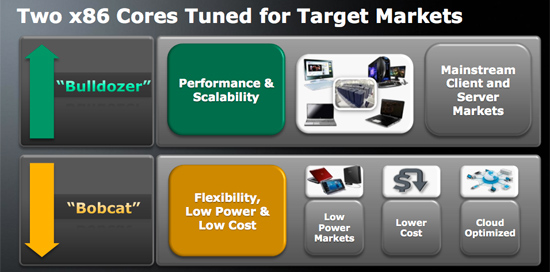
Generally a single microprocessor architecture can cover an order of magnitude of power envelopes. You can take an architecture from 10W - 100W using clock speed, voltage scaling and disabling features (e.g. cutting cache sizes). You can’t efficiently take a 100W architecture and scale it down to 1W. Intel realized this with Atom, and what resulted was a new architecture designed to span the 0.5W - 5W range. Given the constraints of the process (Atom was built at 45nm) and a desire to keep die size down to a minimum (and thus maximize profits), Intel went with a dual-issue in-order architecture reminiscent of the old Pentium - but with a modern twist.
AMD came to the same realization. For it to compete in these value markets, AMD couldn’t rely on its existing Phenom II derived architectures. The Phenom II and its relatives currently span a range of TDPs from 9W to 140W, and at the lower end of that spectrum we’re talking about some very low clock speeds and performance targets. Getting down to 1W was out of the question without a separate design.
What AMD came up with was a core called Bobcat, initially targeted for netbooks, notebooks, nettops and entry level desktops. Architecturally Bobcat is a significant step ahead of Atom: while still dual-issue, it features an out-of-order execution engine making it the Pentium Pro to Atom’s Pentium.
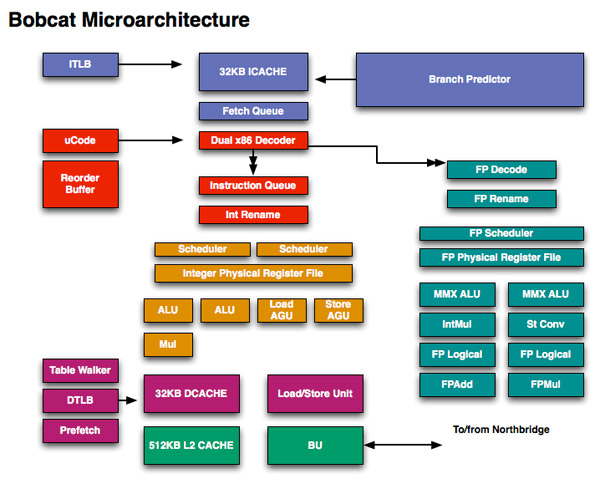
It isn’t just CPU architecture that AMD surpassed Atom with, the first incarnation of Bobcat is an integrated SoC with on-die DirectX 11 GPU. AMD calls this combination a Fusion APU (Accelerated Processing Unit) as it places both a CPU and GPU on a single die. The possible CPU/GPU combinations for Bobcat based APUs are listed in the table below:
| AMD Brazos Lineup | ||||||||
| APU Model | Number of Bobcat Cores | CPU Clock Speed | GPU | Number of GPU Cores | GPU Clock Speed | TDP | ||
| AMD E-350 | 2 | 1.6GHz | Radeon HD 6310 | 80 | 500MHz | 18W | ||
| AMD E-240 | 1 | 1.5GHz | Radeon HD 6310 | 80 | 500MHz | 18W | ||
| AMD C-50 | 2 | 1.0GHz | Radeon HD 6250 | 80 | 280MHz | 9W | ||
| AMD C-30 | 1 | 1.2GHz | Radeon HD 6250 | 80 | 280MHz | 9W | ||
AMD avoided branding its first APUs, they’re simply the AMD E-series and C-series Fusion APUs. The emphasis isn’t on the CPU or the GPU in this case, just the company name and a model number.
| CPU Specification Comparison | ||||||||
| CPU | Manufacturing Process | Cores | Transistor Count | Die Size | ||||
| AMD Zacate | 40nm | 2 | ? | 75 mm2 | ||||
| AMD Thuban 6C | 45nm | 6 | 904M | 346mm2 | ||||
| AMD Deneb 4C | 45nm | 4 | 758M | 258mm2 | ||||
| Intel Gulftown 6C | 32nm | 6 | 1.17B | 240mm2 | ||||
| Intel Nehalem/Bloomfield 4C | 45nm | 4 | 731M | 263mm2 | ||||
| Intel Sandy Bridge 4C | 32nm | 4 | 995M | 216mm2 | ||||
| Intel Lynnfield 4C | 45nm | 4 | 774M | 296mm2 | ||||
| Intel Clarkdale 2C | 32nm | 2 | 384M | 81mm2 | ||||
| Intel Sandy Bridge 2C (GT1) | 32nm | 2 | 504M | 131mm2 | ||||
| Intel Sandy Bridge 2C (GT2) | 32nm | 2 | 624M | 149mm2 | ||||
These APUs do need the aid of an additional chip - the Hudson Fusion Controller Hub (FCH). The FCH adds support for things like SATA, USB, Ethernet and Audio.The Hudson FCH is very tiny measuring approximately 4mm x 7mm for a total die size of around 28mm2.
The combination of these Bobcat based APUs and the FCH is called the Brazos platform.
Late last year AMD invited me to spend several hours with a Brazos system at its brand new campus in Austin, TX. While the preview gave us some insight into what we could expect from Brazos, I didn’t have enough time to really dive in as much as I would’ve liked to.
Earlier this month, AMD officially launched Brazos with hardware expected sometime this quarter. For the past couple of weeks I’ve been testing a Brazos mini-ITX motherboard from MSI and today, it’s time to break the silence and share the results. They are quite good.


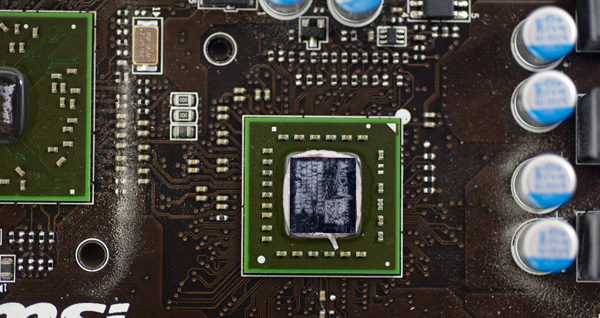
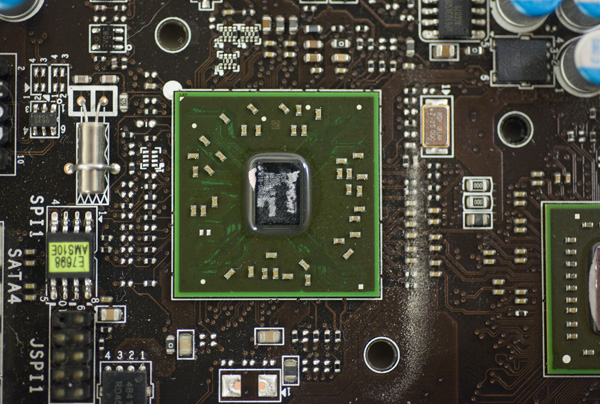
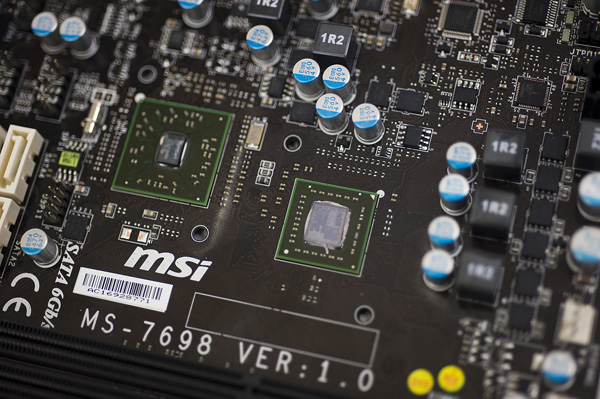
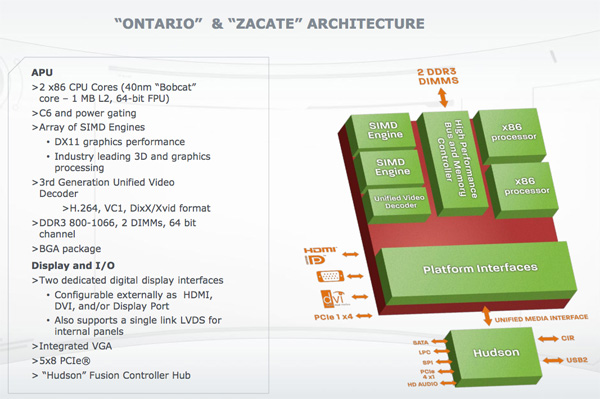








176 Comments
View All Comments
rpsgc - Thursday, January 27, 2011 - link
It will run at x4 (comparable to PCI-E 1.1 x8)rpsgc - Thursday, January 27, 2011 - link
Since I can't edit my post...... look here for the performance penalty of running at x4 versus x16
http://www.techpowerup.com/reviews/AMD/HD_5870_PCI...
codedivine - Thursday, January 27, 2011 - link
Thanks!codedivine - Thursday, January 27, 2011 - link
I was wondering if it is possible to overclock this mobo+APU combo?allzhat - Thursday, March 15, 2012 - link
I use K10stat to increase the multiplier for my notebook (e350) from x16 to x18 (1800Mhz)or even x22 (2200Mhz), but I can't feel more performance for this APU but it draw more power consumption and heat of courseI suggest to use gamebooster for heavy application
PS: I'm sorry for my bad english
nitrousoxide - Thursday, January 27, 2011 - link
So an SSD really makes difference on Brazos platform? Now I can place my order :)My choice is Corsair Nova 64GB since it is the cheapest drive with the minimum accpetable space I need. Any drive cheaper than this one is not big enough and bigger ones are more expensive... Hope its low Random Read performance doesn't impact much, at least faster than an HDD!
Dark_Archonis - Friday, January 28, 2011 - link
Being cheap with SSDs? Good luck when you suffer reliability problems with your SSD.nitrousoxide - Friday, January 28, 2011 - link
Guess what? Somebody ran an durability test for an Intel X-25V, a non-stop read--write-erase cycle for 300 days and still working. Performance began to drop after 6 months, but keep in mind that this stress test is over 20 times beyond daily use. So it actually takes years to destroy an SSD, without SF controller, of course :)mariush - Sunday, January 30, 2011 - link
A sample of ONE is by no means enough. The same person could have tested a second SSD and have it die on him after a week.After all that's what MTBF is all about - the average time for a failure in a population of identical devices.
Ethaniel - Thursday, January 27, 2011 - link
Is it me or the Nano X2 just beats the crap out of both Brazos and Atom? Can we get a review of that chip, Anand?